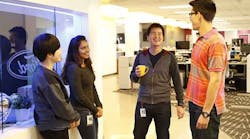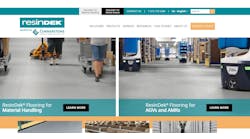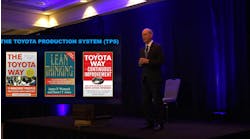Opened in 2015, Ford’s Research and Innovation Center in Palo Alto, Calif., ticks off all the boxes that intrepid tech minds have come to expect to do their work properly. Bean bag chairs: check. An open kitchen the size of Rhode Island, with funky mismatched lighting and stainless steel refrigerators stocked with subtly flavored sparkling waters: check.
Décor aside, though, the center is punctuated with gadgetry: real, tactile projects are going on. With autonomous vehicle simulators that allow virtual interaction with pedestrians and bikes with sensors to gather street-by-street data on microclimates, Ford’s space offers a nod not just to Google X but to Thomas Edison’s Menlo Park workshop down the road. This place is about code, but it’s about making machines, too.
The center is also key to Ford’s recruiting strategy. Jeffrey Keiffer, Ford’s human resources manager in Silicon Valley, makes sure the company does a lot of entertaining here, hosting informal gatherings on topics like cybersecurity and big data and analytics. Just the week before, around 70 user experience people from various startups paid a visit to the center for such a Meetup.
“They were all interested in what Ford was doing in the market,” says Keiffer.
The site has hosted some 200 startups since it opened, along with venture capitalists, university researchers and coding whizzes. “It’s becoming a part of the network, the fabric out here to meet, to introduce ourselves to the Bay Area and to these companies, and they introduce themselves to us,” says Keiffer. “When you have all this interaction, a lot of things can happen. It starts polishing your brand. People begin to understand, ‘Boy, this is a great place to work.’”
Ford, like other OEMs, has had to be more creative in its recruiting or risk losing ground to tech companies like Google and Apple that are working on autonomous vehicles and also want to operate in the automotive space. “The tech companies, they’ve been thinking about [talent] for a long time,” says Gary Silberg, lead automotive analyst in the Americas for KPMG. “In the beginning they’d get small teams and their friends and a really tight network of people they know. It’s a very clubby group. Once you’re of some size it becomes more tactical and strategic.”
In just the past year or two, the race to build the first fully autonomous vehicle has morphed into a ferocious sprint to score the best talent in robotics and software engineering. Apple has hired away engineers from Tesla. Google Car scooped up former Hyundai CEO John Krafcik to run its Self Driving Car Project. Tesla wooed away Apple’s director of recruiting in December, and a month later it hired Jim Keller, a veteran of Apple, as its vice president of hardware for its Autopilot navigation system.
“The [talent] shortage is ridiculous,” says Michael Solomon, managing partner of tech recruiting firm 10x. “And it’s going to get more ridiculous. Not educating people in science and technology from the ground up to meet the demand is going to be a big challenge for us as a nation.”
“We’re hearing lots of stories of people leaving one company and going to work for the other and getting an outrageous offer and they’re out the door,” says Richard Wallace, director of the Transportation Systems Analysis Group at the Center for Automotive Research in Ann Arbor. “Apple’s been hiring people from Ford and Bosch. It’s an arm race for the people who can make this happen.”
Though fully autonomous vehicles are at least five years away, “any automaker that’s not actively developing that technology is certainly at risk of getting left behind,” says Ed Kim, industry analyst for California market research firm AutoPacific. According to his company’s most recent data, one in five vehicle owners say they would be interested in purchasing an autonomous vehicle, “and that’s without any marketing, and very little awareness.”
Meanwhile, “traditional automakers are finding that they’re all of a sudden having to compete for engineers, and that’s something that really hasn’t happened before.”
OEMS looking for top-notch people to build autonomous vehicles are buying startups to acquire new talent, like Toyota did recently with MIT-grad-staffed Jaybridge Robotics and General Motors did with Cruise Automation. With acquisitions, “in the near term, if you get access to a highly talented workforce, there’s a value to that,” says Silberg.
The legacy auto companies are also adding previously unheard-of words like “dog-friendly” and “work from home” to their lexicons, or setting up cooperative working spaces in cities known more for their biking paths or music scenes than their car factories.
Though the cultural shift is big, they may be starting to get it. The Silicon Valley meetups that Keiffer talks about are “exactly what Ford needs to be doing,” says Solomon. “That couldn’t be more on the right track.”
A Dearth of Deep Learning Expertise
Last year, Uber famously poached 40 researchers from the Robotics Institute at Carnegie Mellon University in Pittsburgh for its own autonomous vehicle research. Martial Hebert, a computer vision expert and the Robotics Institute’s director, says that even with a fully staffed operation, the school couldn’t turn out software and robotics engineers fast enough.
The institute offers a Ph.D. program and three master’s programs: in general robotics, robotics system design and computer vision, a one-of-a-kind program in the U.S. that covers “what’s becoming an important subfield,” says Hebert.
While he can’t go into specifics, Hebert says the industry is “starved” for such expertise. This year’s class of 300 graduates has “multiple offers coming out,” even with the program increasing the number of graduates by 30 to 40% this year alone.
Hebert says the uptick in demand started a couple of years ago, not just from the automotive industry but “from companies that you would not think of as being robotics companies—hospitality, manufacturing, construction--investing large amounts of money in it.”
Carnegie Mellon is trying to expand its program, says Hebert, but it takes time to forge partnerships and find new funding and more space. He talks about the need to “preserve the pipeline” of expertise from university to the private sector and worries that if multibillion-dollar corporations can just cherry-pick talent from universities, there won’t be anyone left in the classroom to develop a new crop of robotics scientists.
“Sometimes you see statements that robotics is now a matter that should be handled entirely by industry,” Hebert says. “The fact is we still need to provide people” to develop the technology and staff the industrial efforts. “This is a critical issue that goes to the national strategy in robotics. We cannot do this independently.”
CAR’s Wallace says the need for robotics engineers (and in general, engineers who have a feel for good design and can think abstractly) stems from discoveries about a dozen years ago, when artificial intelligence research began a shift from “if, then” computer code “that was never working right” to the deep machine learning of a Google self-driving car or Go Computer.
“Suddenly they realized, borrowing off the [biological] neural network, you had to program in the ability to learn. Basically you were trying to create a two-year-old, and its ability to absorb knowledge. That was a branch of artificial intelligence and computer science called neural network theory, and that morphed into machine learning, and now the buzzword is deep learning.”
The basics of sensors, cameras, radar and LIDAR to replace eyeballs and ears is the easy part, says Wallace. “The hard part, the challenge, is replacing the human brain. In terms of the demand curve, that’s what everybody wants now, so they can compete.”
Meanwhile, universities are scrambling to catch up. “These type of skill sets and this type of learning has only been taught in the last 5 to 7 years,” says Laurie Phelps, a Ford HR supervisor who is Keiffer’s tech recruiting counterpart in Dearborn.
A New Kind of Engineer
At Ford, says Keiffer, the most sought-after positions are research scientist and research engineers for Ford’s autonomous vehicle development. “Machine learning and neural networks and image processing are all very important.”
The top schools for this type of expertise—Stanford, Carnegie Mellon, MIT and Princeton—have a finite number of graduates (it’s no coincidence that Ford CEO Mark Fields recently spoke in person to Stanford’s engineering class). To expand the pool, OEMs and tech companies are looking hard at other schools with pieces of a robotics curriculum or an emphasis on engineering design: Northwestern University and University of Michigan, for instance.
Toyota recently announced that it’s building an offshoot of its Artificial Intelligence Institute, one focused on autonomous vehicle research, right across from the University of Michigan. And Foothill College, a community college in Los Altos Hills, Calif., says Wallace, is a favorite Silicon Valley source for people who “can write code all day.”
But the rarest birds are “engineers who can think at higher levels of abstraction,” says Wallace. “People are going to be using these things, so designing for the end user and how that fits in” is important. “We need the educational system to start churning out [talent] faster. Right now, it’s competition quite honestly, and the companies that move faster are getting it.”
Software engineers can earn, on average $80,000 to above $100,000 a year coming right out of college to a job with one of the automotive companies, say Wallace and others interviewed. But even though that’s a hearty chunk of change for the average college graduate, it won’t catapult anyone to the ranks of the one-percenters.
“One of the things that I’ve heard from companies, the auto industry model of ‘It’s a job and you earn a salary’ is very different from the Silicon Valley model of ‘you come in and you work really crazy hard and the company goes public and you’re a millionaire,’” says Wallace. “So it’s more difficult, I think, to attract people to the auto industry in California because it’s a job with a salary and benefits, and it’s more staid than a lot of companies they could have opportunities with.”
It’s also more precise. “You can’t screw up. Tolerances, errors in software on your car are much, much tighter than on your Windows computer.”
Zigging Instead of Zagging
While GM, Ford, and Toyota were moving into their innovation centers in Silicon Valley, Jaguar Land Rover took a different approach to talent: setting up a tech incubator in the cheaper creative hub of Portland, Ore., where the average home cost is $375,000—compared to over $1 million in Silicon Valley, according to data from real estate site Redfin.
“There’s a million ways to skin the cat,” says Ian Beavis, chief strategy officer at AMCI, a consulting firm for the automotive industry. “You’ve got the Detroit Three and the Japanese, and then you’ve got companies who don’t have the deep pockets like a Jaguar Land Rover who have been able to attract talent for different reasons.”
Beavis says Portland was a smart move because it’s far enough away that JLR doesn’t have to compete with Silicon Valley companies for talent—Portland has plenty of its own talent. “It’s a great place to live; it’s a great place to bring up a family; people go there to stay,” he says. “It’s a livable city in the Northwest. It’s near Seattle—so there’s a lot of very talented people in that part of the world. And engineers generally, and aerospace."
JLR doesn’t hire the tech innovators; it gives them space to create and a dedicated team of 50 JLR engineers to work directly with them, in exchange for an equity stake in the projects the startups are working on. “That’s a way to approach the problem without necessarily throwing tons of money at it,” says Beavis. “You’ve got a highly educated workforce who frankly want to live in an area like the Northwest for quality of life decisions. So they’re basically zigging when everyone else is zagging.”
In a similar vein, BMW and Tesla share with Silicon Valley tech companies a culture of hiring freelancers for specific projects, says Solomon, who used to work in the music industry and whose firm specializes in contract work for what he calls the “rock stars” of the tech world. Hiring innovators on a contract basis “is not something that large legacy companies are comfortable with or equipped to do. But you can get the top-level people who you’d never get to move to Detroit to come solve your problems.
“Former CTO’s from major companies, including hardware and robotics and virtual reality, these are incredibly bright and talented people who are excited to solve hard problems. They have a much bigger sandbox to play in.” he says. “They want to come in, get paid to solve a problem, and then move on to the next gig.” And if they’re in Tampa, they want to work from Tampa. “For certain things, you need in your work environment to be left alone, so you can get into the zone,” he says.
Ford’s ideal candidate may be more along the lines of a software engineer with student loans for whom a nice regular paycheck and 9 to 5 hours have certain allure, or someone who cares about working for a company that is deeply invested in corporate responsibility and mentorship. Or simply someone with a tech degree and a passion for cars. Those candidates are out there, says Keiffer. “Since I’ve been here I’ve noticed that there’s a certain segment of people that love the idea that they’re working on code and software development and it’s attached to a vehicle,” he says.
Beavis notes that with the strides in autonomous vehicle technology, the negative attitudes from people in software toward automotive manufacturing are changing. “I don’t think they look at the auto industry as an old smokestack, metal-bending industry,” he says. “It is a high-tech industry.”





